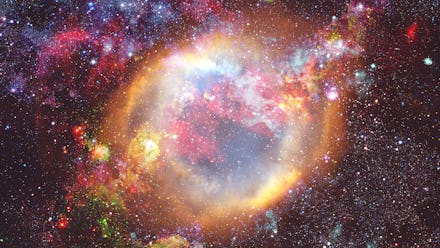Our galaxy had a massive explosion as recently as 1 billion years ago

It turns out that the Milky Way, the very galaxy we currently inhabit, was a tumultuous place to be just one billion years ago. When it comes to describing events in space, that's a relatively recent timeframe, especially if you're talking a massive chain of explosions. According to a new study published in Nature Astronomy, around 100,000 stars at the center of the Milky Way suddenly burst into supernovae, a series of the biggest explosions humans have ever seen, according to NASA.
According to Francisco Nogueras-Lara, astronomer at the Max Planck Institute for Astronomy in Germany and lead author of the study, the mass star death was an impressive visual. It was likely "one of the most energetic events in the whole history of the Milky Way," in fact.
"The conditions in the studied region during this burst of activity must have resembled those in 'starburst' galaxies," he said of the Milky Way meltdown a billion years ago. Starburst galaxies are those in which stars form much, much faster than the rate at which normal galaxies can spawn them. These explosions are findings conclusive that our Milky Way has experienced periods of "rest" over its lifespan after it burst into being some 13 billion years ago, punctuated by short but violent bursts of activity here and there. This activity left its own "imprint," according to Nogueras-Lara, on the Milky Way over time.
Using the GALACTICNUCLEUS survey at the European Southern Observatory's Very Large Telescope in Chile, researchers performing the study were able to use special infrared wavelengths that showed off some of the changes at the center of the Milky Way left behind after the massive chain of explosions. Using the information gleaned from the changes observed via the telescope, Nogueras-Lara and his team were able to deduce that around 80 percent of the stars in the Milky Way now were actually created during its first five billion years in existence, and then the explosions were relatively dormant for billions of years.
Scientists aren't exactly sure what caused the explosions just yet, and there are still plenty of questions that remain unanswered. It isn't clear, for example, where additional material that the Milky Way could potentially have consumed and then "spit out" by way of gravity, causing the explosions, could have come from. In fact, there's a lot more than that about the Milky Way that we just have no clue about. Researchers are still hard at work on deciphering the truth, however, so it's possible an answer may surface in the near future.
"Future spectroscopic and high-angular-resolution imaging follow-up observations will be able to constrain the different events further and teach us about the formation history of the Galactic Center and its implications on the evolution of the Milky Way and its supermassive black hole," Nogueras-Lara and his colleagues wrote. Hopefully these additional discoveries will help us inch ever closer to understanding even more about the formation and early infancy of the galaxy we call home.